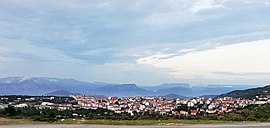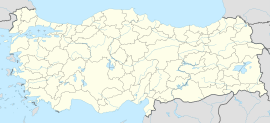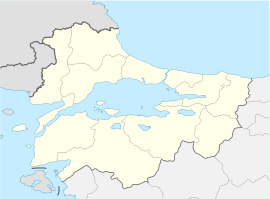This article needs additional citations for verification. (December 2010) |
Söğüt (Turkish pronunciation: [ˈsœ.yt], lit. 'willow') is a town in Bilecik Province, Turkey. It is the seat of Söğüt District.[2] Its population is 13,566 (2021).[1] The mayor is İsmet Sever (MHP), elected in 2019.[3]
Söğüt | |
|---|---|
 | |
| Coordinates: 40°1′7″N 30°10′53″E / 40.01861°N 30.18139°E | |
| Country | Turkey |
| Province | Bilecik |
| District | Söğüt |
| Government | |
| • Mayor | İsmet Sever (MHP) |
| Population (2021)[1] | 13,566 |
| Time zone | UTC+3 (TRT) |
| Postal code | 11600 |
| Area code | 0228 |
| Website | www |
Söğüt is notable as the founding location and first capital of the Ottoman Empire from 1281 to 1335.
Name and etymology
editThe name of the settlement is first attested under the Greek name Thēbásion (Greek: Θηβάσιον or Θηβάσιο) in 13th century. According to Ottoman cadastral record books of 1487 in Hüdavendigâr area the town was registered under the Turkish name Beğsöğüdü or Bey Söğüdü, and this name took the form Söğüd in government records after the first half of the 17th century.[citation needed]
A Greek rendering of the Turkish name, Sogoútē (Greek: Σογούτη), is attested in late Byzantine sources. Laonikos Chalkokondyles also wrote that Itaías Kṓmē (Ἰταίας Κώμη) was an older Greek name for Söğüt, but since Greek "itéa" (ἰtέα) and Turkish söğüt both mean "willow", Klaus Belke considers this "more of a learned translation" than a genuine older name for the town.[4]: 1010
History
editThis section needs additional citations for verification. (October 2016) |
The town was originally known under the name Thêbásion and lay on a strategically important road between Nicaea and Dorylaion that was part of the Pilgrim's Road.[5] It was conquered by Ertuğrul for the Anatolian Seljuks from the Nicean Empire in 1231.[6] Ertuğrul and his tribe (allegedly part of the Kayi tribe/branch of the Oghuz Turks who invaded Anatolia in the 12th and 13th centuries) migrated and settled there during the Mongol invasion after the Battle of Köse Dağ. Ertuğrul ruled from here until his death and also made a mosque for the Muslims living there, including a well which could be used for Ablution. The mosque is still located in there as Ertuğrul Gazi Mosque. As the Rum Seljuk state collapsed, Söğüt became the centre of the Beylik of the Osmanoğulları or Osmanlı Beylik (which later expanded to become the Ottoman Empire). Söğüt was the birthplace of Osman I who continued the raids and conquests into Byzantine territory during his reign from 1299 to 1324. When Osman's son, Orhan, came to power after his father's death, he renamed the Kayi tribe Osmanli in honour of his father.
The village of Thebasion until 1231 served during this time as the capital of the Osmanlı Beylik until the capture of the Byzantine city of Proussa (Bursa) in 1326 that succeeded it as the administrative centre of the Beylik. Söğüt, as the place became known, had a kaza centre in the Ertuğrul Sanjak of Hüdavendigâr Vilayet, the centre of which was Bilecik. The kaza centre included present-day districts of İnhisar, İnönü, Mihalgazi, Sarıcakaya and Yenipazar, central and eastern parts of Bozüyük and some villages of Nallıhan and Tepebaşı before World War I.
Modern era
editSöğüt was occupied three times by the Greek Army during the Turkish War of Independence: 8–11 January 1921, 24 March-21 April 1921 and 12 July 1921 – 6 September 1922.
Today Söğüt is a small town in the humid river valley of Bilecik Province in Turkey. Turkish history and life-size statues of the Ottoman sultans are exhibited in the Söğüt Ethnographical Museum. It is also the 3rd biggest district center in its province after Bozüyük and Bilecik.
References
edit- ^ a b "Address-based population registration system (ADNKS) results dated 31 December 2021" (XLS) (in Turkish). TÜİK. Retrieved 30 January 2023.
- ^ İlçe Belediyesi, Turkey Civil Administration Departments Inventory. Retrieved 30 January 2023.
- ^ Başkanın Özgeçmiş, Söğüt Municipality. Retrieved 21 June 2023.
- ^ Belke, Klaus (2008). Tabula Imperii Byzantini Bd. 13. Bythenien und Hellespont. Wien: Johannes Koder. ISBN 978-3-7001-8329-7. Retrieved 19 June 2024.
- ^ Lindner, Rudi Paul (2007). Explorations in Ottoman Prehistory. University of Michigan Press. p. 45. ISBN 9780472095070. Retrieved 4 July 2023.
- ^ Farrell & Fairey 2018, p. 113.
Sources
edit- Farrell, Brian P.; Fairey, Jack, eds. (2018). Empire in Asia: A New Global History From Chinggisid to Qing. Vol. 1. Bloomsbury Publishing.

